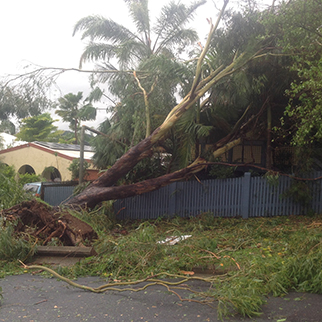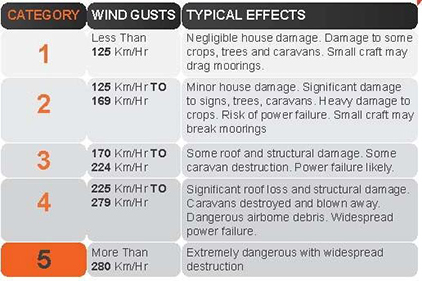
Cyclone Season in Australia is between November and April.
Cyclones are violent storms that contain high winds rotating around a calm centre of low pressure. Winds produced can be in excess of 200km/hr which can cause extensive damage, and can result in death or injury caused by flooding, buildings collapsing or flung debris.
The Bureau of Meteorology (BOM) is Australia's national weather, climate and water agency. Its expertise and services assist Australians in dealing with the harsh realities of their natural environment including drought, floods, fires, storms, tsunami and tropical cyclones. For more information visit the BOM website.
Cyclone Categories
Cyclones are categorised into 5 categories and when a cyclone warning is issued, these categories will help you determine what level of precautions you will need to take, and what damage can result.

It is important to have a thorough understanding of cyclones and the impact that they can have on our Shire. Ensure you take the time to visit the Get Ready website and take the necessary precautions.
Cyclone Warnings
A tropical Cyclone Warning includes information on where the cyclone is, what its movement and direction is, and how strong it is and, identifies the areas that could be affected or at risk.
Tropical cyclone watch: Issued if a cyclone is expected to affect coastal communities within 48 hours, but not expected within 24 hours.
Tropical cyclone warning: Issued if a cyclone is affecting or is expected to affect coastal communities within 24 hours.
Information on current cyclone warnings can be found on the BOM website
Visit the Tropical Cyclone Knowledge Centre to gain a better understanding
Be Prepared!
To be prepared in the event of a cyclone, check your house and roof is in good condition; trim tree branches well clear of your house; clear property of loose sheet iron and other potential missiles (including outdoor furniture); prepare an emergency kit including a battery-operated radio; upon a Cyclone Warning, listen to radio (837AM ABC) and/or television for further advice.
Make sure you fill as many water containers as possible, close shutters, board up or heavily tape all windows, prepare the strongest part of your building (usually an internal hallway or bathroom) using strong tables and mattresses and beware of the eye of the storm.
Secure boats and caravans, move vehicles and bicycles undercover. Charge electronic devices. Decide how you will look after your pets and animals, and what you will do if you have to leave them behind. Pets are not permitted in cyclone or evacuation centres. Let your neighbours know a cyclone watch/warning has been issued.
As a property owner you will need to identify whether you will evacuate your property or wait the cyclone out within your home.
Properties constructed after 1982 are generally structurally sounds to withstand a cyclone.
Visit the Disaster Dashboard for up to date information